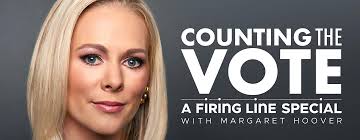As the election nears, we can fret about all the ways that vote-counts can go wrong. Or we can marvel that they rarely do.
“Think about what a miracle an election is,” said David Becker, head of the non-partisan Center for Election Innovation and Research. “We count 160 million pieces of paper” and do it “exceptionally fast.”
And it’s done in a wildly decentralized way. “We practice a fierce federalism,” said Ralph Ginsberg, a Republican election lawyer for 40 years.
Each state sets its own rules, often leaving room for local variations. The result, Becker said, is “a system of 10,000 different jurisdictions and hundreds of thousands of volunteers.”
They were talking to the Television Critics Association about “Counting the Vote,” a Margaret Hoover (shown here) film that airs Aug. 27 on PBS. And this was a truly bi-partisan collection.
There was one Democrat (Jocelyn Benson, Michigan’s secretary of state), one non-partisan (Becker) and two Republicans (Ginsberg and Margaret Hoover). She hosts the special … hosts the reboot of William F. Buckley’s “Firing Line” … and is the great-granddaughter of President Herbert Hoover.
These four people might not be expected to agree on anything. Still, all four say the recent elections were fair.
“They’re more secure, transparent and verifiable than they’ve ever been,” Becker said. “The problem is that people who lose elections are willing to delude and lie to their supporters.”
Ginsberg has presented the Republican view in court often, getting crucial wins in the 2000 Florida presidential race. But this time, he said, people pushing the unfair-election side got nowhere. “The evidence was presented in court 64 times, post-election, with no results,” then was followed by “a total unwillingness to accept the rule of law.
And new versions keep appearing. “There’s been a lot of creativity in the conspiracy-theory realm,” Hoover said. “I think you’ll see new variations.”
Nowadays, 95 percent of all votes include paper ballots that are easy to count and recount. “It’s impossible to really stuff drop boxes and have those ballots counted,” Benson said.
But rumors persist. When a crew came to film a counting center in Detroit, it brought boxes of equipment. A rumor spread that the boxes contained votes; soon, a crowd was banging on the glass, demanding to get in.
But inside that room, Becker said, there were already “hundreds of observers, representing both parties, … doing what their job always was.”
There were flaws with the system, Benson said, but they involved speed, not accuracy. Michigan was one of many states in which the processing of early votes couldn’t begin until Election Day.
“We could only start counting these millions of ballots at 7 a.m. …. I could predict that Pennsylvania and Arizona were probably not going to be done until Friday,” Benson said.
That will be different this time, Hoover said. “Michigan has passed a slate of sweeping reforms in order to hopefully make it easier (and) clarify” issues.
The state and others have also taken steps beyond legislation, Becker said. “One of the things election officials do all over the country – Michigan’s a great example, but this is true everywhere – is … intense transparency.”
But sweeping reforms can also be re-reformed. “Each party, when it gets in power, tries to basically shape elections laws to help it,” Ginsberg said.
The PBS special starts and ends with examples in Florida:
— After the election chaos in 2000, Jeb Bush, the Republican governor, pushed legislation to transform the system. It passed unanimously.
— Twenty years later, another Republican governor, Ron DeSantis, praised Florida’s 2020 work as “the gold standard” of elections.
— Later, DeSantis signed two bills overhauling the system he had praised.
Such maneuvers follow a logical pattern, Ginsberg said. “Democrats believe that the more voters who vote, the better it is for Democrats. Republicans believe in shrinking the electorate.”
Democratic states often go for early voting, drop boxes and more; Republicans resist. But there are exceptions; Hoover points to “Utah: Republican state, mail-in voting, dropboxes, completely secure.”
And on both sides, Ginsberg said, this is based on the assumption that the voters who are easiest to discourage are Democrats. But “the low-propensity voters, who used to be known as working-class Democrats – have now shifted to the Republican base.” Vote-stifling could backfire.

Counting the votes? Here (really) is bipartisan consensus
As the election nears, we can fret about all the ways that vote-counts can go wrong. Or we can marvel that they rarely do.
“Think about what a miracle an election is,” said David Becker, head of the non-partisan Center for Election Innovation and Research. “We count 160 million pieces of paper” and do it “exceptionally fast.”
And it’s done in a wildly decentralized way. “We practice a fierce federalism,” said Ralph Ginsberg, a Republican election lawyer for 40 years.
Each state sets its own rules, often leaving room for local variations. The result, Becker said, is “a system of 10,000 different jurisdictions and hundreds of thousands of volunteers.”
They were talking to the Television Critics Association about “Counting the Vote,” a Margaret Hoover (shown here) film that airs Aug. 27 on PBS. And this was a truly bi-partisan collection. Read more…